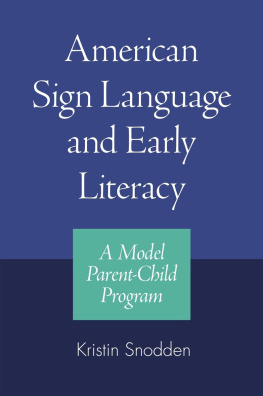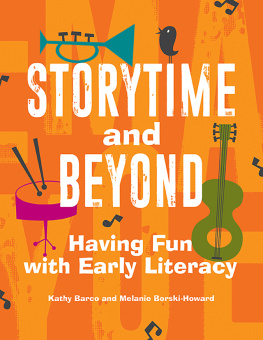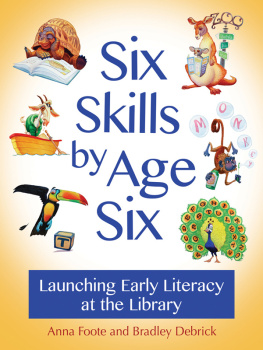Contents
American Sign
Language and
Early Literacy
American Sign
Language and
Early Literacy
A Model Parent-Child Program
Kristin Snoddon
Gallaudet University Press
Washington, D.C.
Gallaudet University Press
Washington, DC 20002
http://gupress.gallaudet.edu
2012 by Gallaudet University
All rights reserved. Published 2012
Printed in the United States of America
Library of Congress Cataloging-in-Publication Data
Snoddon, Kristin.
American Sign Language and early literacy : a model parent-child program / Kristin Snoddon.
p. cm.
Includes bibliographical references and index.
ISBN 978-1-56368-527-9 (hbk. : alk. paper)ISBN 1-56368-527-2 (hbk. : alk. paper)ISBN 978-1-56368-528-6 (e-book)ISBN 1-56368-528-0 (e-book)
1. American Sign Language. 2. Sign language acquisition. 3. Early childhood special education. 4. Special educationParent participation. 5. Deaf childrenLanguage. 6. Children of deaf parentsLanguage.
I. Title.
| HV2476.4.S66 2012 |
| 371.91246dc23 | 2011048173 |
originally appeared as American Sign Language and Early Intervention in The Canadian Modern Language Review (64[4], 581604).
 The paper used in this publication meets the minimum requirements of American National Standard for Information SciencesPermanence of Paper for Printed Library Materials, ANSI Z39.48-1984.
The paper used in this publication meets the minimum requirements of American National Standard for Information SciencesPermanence of Paper for Printed Library Materials, ANSI Z39.48-1984.
It is only when the oppressed find the oppressor out and become involved in the organized struggle for their liberation that they begin to believe in themselves. This discovery cannot be purely intellectual but must involve action; nor can it be limited to mere activism, but must include serious reflection: only then will it be a praxis.
Paolo Freire
Contents
Acknowledgments
M Y INVOLVEMENT with the field of ASL and early literacy is due largely to the support and inspiration provided by Joanne Cripps and Anita Small. The staff and board members of the Ontario Association of the Deaf have also provided me with myriad forms of support. I wish to convey special thanks to Jennifer Jackson for having hired me in the summer of 2006 to write a discussion paper about Ontario public service gaps to young Deaf children that became a foundation for my study. I am also indebted to Jim Cummins and to Eunice Jang for the guidance they provided for my research.
I could not have conducted my study without the collaboration of the Ontario Cultural Society of the Deaf or of the parents who participated with their children in our ASL Parent-Child Mother Goose Program. Kevin Canning volunteered his time and expertise to film our program, while Jason Theriault provided invaluable technological assistance throughout and beyond my study.
Finally, I would like to thank my husband, Christopher Pellow, who was there for me in the beginning and saw me through to the end of my study. With his love and support my endeavors seem more possible and worthwhile.
T HIS BOOK is about an American Sign Language (ASL) literacy program for Deaf and hearing parents and young children in Ontario, Canada. Underlying this subject are several different lines of inquiry. First, this book describes the present-day context of infant hearing screening and early intervention services for Deaf children and their parents, and the impact these public services have for participants in the program. Second, the processes and outcomes of the ASL Parent-Child Mother Goose Program are described in terms of a counterdiscourse to the dominant discourse of early intervention policy for Deaf children and their parents. This counterdiscourse includes the distinct roles taken by Deaf and hearing parents during the program and by the program leader as a Deaf adult and ASL instructor working to facilitate emergent ASL literacy.
In using the capital D for every instance of the word Deaf, instead of only when discussing individuals who are members of the signing Deaf community, this book follows the convention established by Joanne Cripps (2000). I similarly use the capital D not to place a particular identity on particular individuals, but rather to indicate that signed language and Deaf culture are the birthright of every Deaf person by virtue of him or her having been born Deaf or having become Deaf in childhood, whether or not he or she has been exposed to Deaf culture.
My interest in early ASL literacy is based in part on my professional experience with a Deaf community organization (referred to throughout the book as DCO) that in 2003 founded the ASL Parent-Child Mother Goose Program for teaching ASL rhymes and stories to parents and young children. From 20012005, I was employed by DCO as a program coordinator. In this position, I was responsible for organizing training workshops for ASL instructors who worked with families under the Ontario governments Infant Hearing Program. I also coordinated the program. This program builds on the contributions of Deaf linguist and poet Clayton Valli, whose seminal work in ASL poetry identified ASL rhyme and meter. The program was also developed in collaboration with the original, spoken-language Parent-Child Mother Goose Program and follows the original programs principles and main objectives. In the Parent-Child Mother Goose Program, groups of parents and caregivers are taught oral rhymes, songs, and stories in order to promote parentchild bonding and positive communication, and support childrens language development. The ASL Parent-Child Mother Goose Program focuses on language interaction between parents and young children using ASL rhymes and stories and aims at developing a literary level of ASL while supporting the bond between parent and child.
When DCOs program funding was cut in 2005, I was filled by a sense of injustice at the uneven allocation of public resources for ASL programs and services for families with Deaf children. This sense of injustice is partly why I adopted an ethnographic action research approach for my study. Action research is practical; it aims at producing solutions to real problems. Additionally, action research involves participants as active subjects. Most research in Deaf education consists of quantitative studies that emphasize Deaf peoples perceived deficiencies. A qualitative, collaborative approach stands in contrast to this body of research. Moreover, ethnography is one of the most effective means of studying language practices and language communities (Heath, 1983).
This book therefore tells the story of parents and children participating in an early ASL literacy program in the fall of 2007. This participant group consisted of two families with Deaf parents and Deaf children, one Deaf parent with a hearing child, and three hearing parents with Deaf or hard of hearing children who were registered with a Deaf service agency in the province of Ontario. The program leader, a Deaf adult and ASL instructor, was also a participant, along with me as a researcher. This book also describes an action research methodology that might be used by other individuals seeking to effect change in their communities. This methodology may be termed openly ideological research (Lather, 1986), but this is not to say that other forms of research, including the above-mentioned quantitative studies, are any less ideological. It is simply that I seek to be clear with my intentions: along with other participating individuals in the program, to forward an emancipative literacy for Deaf children, their families, and their community. This book shows how ASL literacy can function as such an emancipative literacy.









 The paper used in this publication meets the minimum requirements of American National Standard for Information SciencesPermanence of Paper for Printed Library Materials, ANSI Z39.48-1984.
The paper used in this publication meets the minimum requirements of American National Standard for Information SciencesPermanence of Paper for Printed Library Materials, ANSI Z39.48-1984.